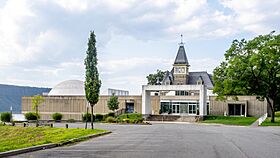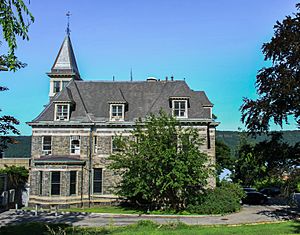Hudson River Museum facts for kids
 |
|
| Established | 1919 |
|---|---|
| Location | 511 Warburton Avenue Yonkers, New York |
| Type | Art museum, Planetarium |
| Public transit access | Metro North Glenwood station |
The Hudson River Museum is a super cool place in Trevor Park, Yonkers, New York. It's the biggest museum in Westchester County. Plus, it has the only public planetarium in the whole county! Even though it has lots of amazing art, especially paintings from the Hudson River School, the museum also teaches you about local history, science, and culture. It's a top-notch museum, recognized by the American Alliance of Museums since 1974.
Contents
A Look Back: Museum History
The museum started way back in 1919. It was first called the Yonkers Museum. Edwin C. Mott began it in just one room at Yonkers City Hall. At first, it mostly showed off minerals. But soon, it grew to include animal specimens, paintings, statues, and other interesting items. People like photographer Rudolf Eickemeyer Jr., sculptor Isidore Konti, and George J. Stengel helped a lot to create the museum.
In 1924, the museum got a new name: the Yonkers Museum of Science and the Arts. It moved to a beautiful old house called Glenview Mansion. This mansion was built in 1877 for a rich financier named John Bond Trevor. The house has amazing carved wood inside, made by a famous cabinetmaker. Around 1940, the museum changed its name again to the Hudson River Museum of Yonkers, which later became just the Hudson River Museum.
In 1969, a much bigger and more modern building was added next to the mansion. This new part cost $1.8 million! It included new art galleries, a planetarium, and even a library branch. A few years later, six rooms in the old Glenview house were fixed up. They were decorated with furniture and items from the 1800s. In 1972, Glenview Mansion was listed as a special historic place.
In June 2023, the museum opened an exciting new part. This new west wing is huge, about 12,000 sq ft (1,100 m2)! It looks out over the Hudson River. This new area has more space for art shows, a big auditorium, a special gallery for community projects, and extra storage for art.
Exploring the Planetarium
The museum has had a planetarium for over 60 years! The very first one was built in 1956 inside the Glenview mansion's dining room. It had a 20-foot dome and could seat 50 people. It used a special projector to show stars.
In 1969, when the museum expanded, a new, bigger planetarium was built. This one had a 40-foot dome and could seat 120 people! In 1987, they got an even better projector that could show 5,000 stars.
In 2014, the planetarium got a big upgrade. It now has a super cool digital system and a projector that can show an amazing 22 million stars! The Hudson River Museum Planetarium is still the only public planetarium in Westchester County. It's also one of the few places that has live presenters for shows, not just pre-recorded ones. During the week, school groups visit. On weekends, the public can enjoy three different shows. The museum also hosts special events, like watching parties for big space events. They've watched things like Mars coming close in 1971, Halley's Comet in 1986, and solar eclipses in 2017 and 2024.
Cool Exhibitions and Programs
In 1979, an artist named Red Grooms created "The Bookstore" at the Hudson River Museum. It's a really unique art piece that you can still see there today!
The museum is known for showing many different kinds of art and ideas. This is why the New York State Council on the Arts called it one of the most unusual cultural places in 1972. The museum has always tried to keep this variety. The museum's 23-acre (9.3 ha) site shows this diversity. In 2006, they worked to connect the old Glenview Mansion better with the newer 1969 buildings.
In 1994, the museum celebrated its 75th birthday. They focused on the Hudson River, which is part of their name, for the celebration. In 2019, the museum celebrated its 100th birthday!
Since 1995, the museum has offered a "Junior Docent Program." This program helps young people learn about the museum and share what they know. It even won an award in 2008!
The Museum in TV Shows
The beautiful old rooms of the museum's Glenview Mansion have appeared in the HBO TV series The Gilded Age. This show is about American history and started in January 2022.
Also, a room and staircase from inside the museum were used in the Apple TV+ series Severance. The outside of Glenview Mansion was even changed to look like a replica of a house in the show!
How the Museum Gets Support
The late 1980s were a bit tough for the Hudson River Museum. They had less money and staff changes. The museum had to open fewer hours and cut some programs. But they were still able to make the planetarium bigger!
Things got much better in the 1990s. The museum received many grants and awards. They also got more money from Westchester County. This helped them expand just in time for their 75th birthday. More people started visiting too! The number of visitors almost doubled from 55,000 to 100,000 between 1990 and 1994.
Later in the 1990s, funding went down again, and the museum had to make more cuts. To help with money, the museum started hosting private events and offering tours, especially for school groups.
In 2023, the museum received a special grant from the Institute of Museum and Library Services. This money helps them turn about 8,000 historical photos into digital files. These photos show the local community and include pictures from the John Bond Trevor family, the Alexander Smith Carpet Factory, artist Alvin Hollingsworth, and photographer Rudolf Eickemeyer Jr..
See also
 In Spanish: Museo del Río Hudson para niños
In Spanish: Museo del Río Hudson para niños


